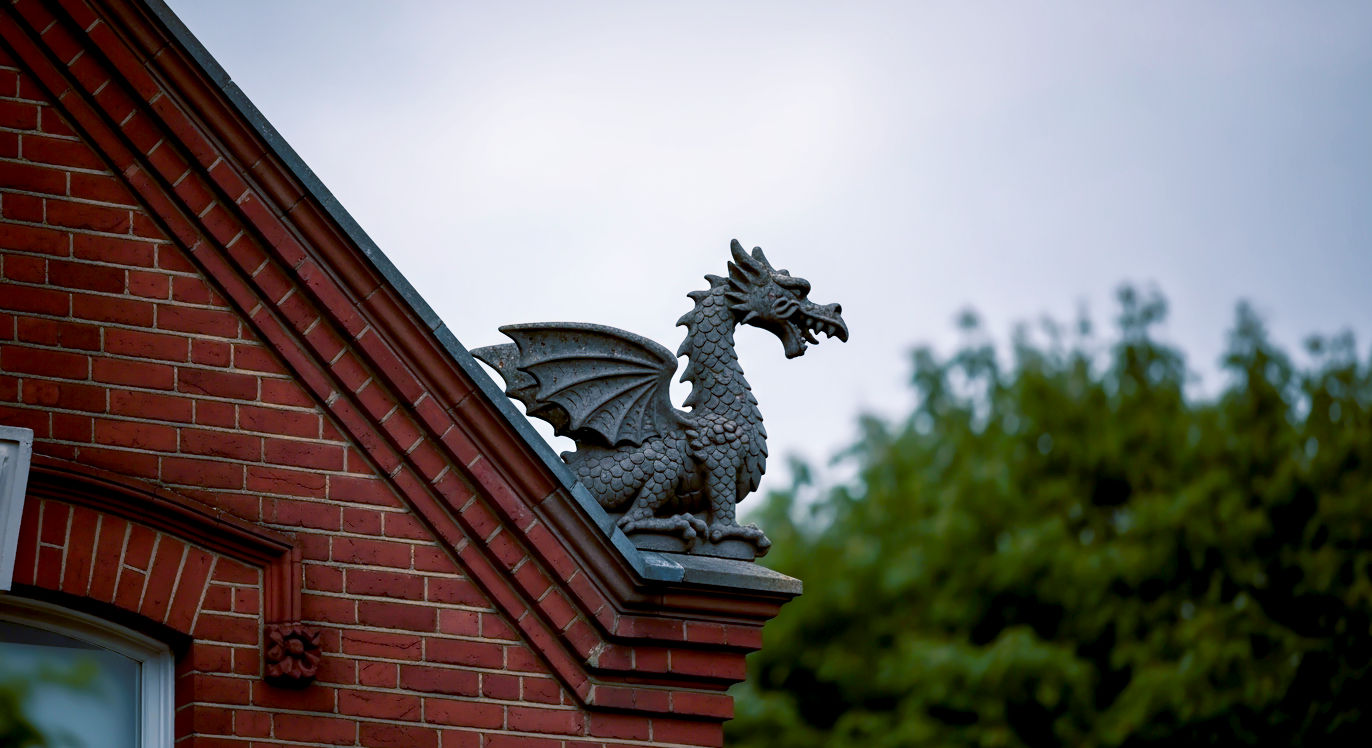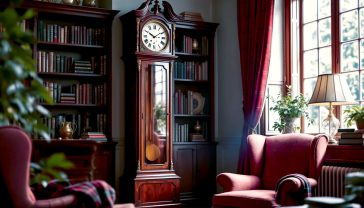The Humble Finial: The Crowning Glory of British Design You Never Knew You Cared About
The guide to finials. Explore their history in British architecture, from Gothic cathedrals to Victorian homes, and learn how to use them inside.

This post may contain affiliate links. If you make a purchase through these links, we may earn a commission at no additional cost to you.
Look up. No, really. Next time you’re strolling down a classic British high street, wandering through a country estate, or even just pottering about in your own home, look up. Perched atop gateposts, punctuating the peaks of roofs, or sitting proudly on the end of a curtain pole, you’ll find them: finials.
They’re one of those brilliant little details we see every day but rarely ever notice. A finial is essentially a decorative ornament that sits on the very top or end of an object. Think of the spike on a Victorian helmet, the carved pineapple on a grand Georgian gatepost, or the simple ball on top of a bedpost. That’s a finial.
It might sound like a tiny, insignificant bit of architectural fluff. But these small flourishes are the unsung heroes of design. They’re the full stop at the end of a sentence, the cherry on top of the cake. They provide a sense of completion, elegance, and character to everything from mighty cathedrals to the humble curtain rail in your living room.
For centuries, these crowning jewels have been a part of Britain’s architectural story. They’ve seen trends come and go, from the soaring ambition of Gothic spires to the restrained elegance of Georgian townhouses and the cosy charm of Arts and Crafts homes. They’re more than just decoration; they’re a quiet nod to history, craftsmanship, and the very British belief that even the smallest details matter. So, let’s take a closer look at these fascinating features and discover why they’re the perfect finishing touch.
What Exactly Is a Finial, Then?
At its simplest, a finial is an ornament that marks the top or end of an object. The word itself comes from the Latin finis, which means ‘end’. And that’s precisely what it does: it provides a neat, decorative end to a structural element. Without a finial, a roof ridge, gable, or post can look abrupt and unfinished, like a story that just stops mid-sentence.
Functionally, a finial can serve a few purposes. On a roof, it might help to weigh down the final tile or slate, protecting it from the famously wild British weather. On a post, it can help to shed rainwater, preventing the wood from rotting. Early finials often had a very practical job to do. For example, a heavy stone finial on a Gothic pinnacle wasn’t just for show; it provided crucial downward pressure that helped stabilise the delicate stonework below.
But let’s be honest, the main reason we love them is for how they look. Aesthetically, a finial is all about emphasis and elegance. It draws the eye upwards, making a roofline seem taller and more dramatic. It adds a point of interest, breaking up a flat surface with a flourish of personality. Whether it’s an imposing eagle on a gatepost or a simple, elegant sphere on a staircase, a finial adds that little bit of pizzazz.
Finials vs. Other Architectural Bits and Bobs
It’s easy to get finials mixed up with other fancy architectural terms. Here’s a quick guide to telling them apart:
- Pinnacle: This is a tall, slender, pyramid-like structure that rises from a roof or buttress, common in Gothic architecture (think of the spiky bits on a cathedral). A finial is the decorative ornament that often sits right on top of the pinnacle. So, the finial is the hat, and the pinnacle is the person wearing it.
- Spire: A spire is a much larger, tapering structure that forms the entire top of a tower, like you’d see on a church. It is the main event, not just the decoration on top.
- Cresting: This is a decorative railing or fringe that runs along the ridge of a roof. It’s a continuous line of ornamentation, whereas a finial is a single, distinct point.
So, while they all live in the same neighbourhood—high up on our buildings—the finial is the specific, singular ornament that provides the final, crowning touch.
A Grand Tour Through History: The Finial in Britain
The story of the finial is woven into the very fabric of British architecture. From the sacred stones of our earliest structures to the clean lines of modern design, these ornaments have been there, quietly telling a story of faith, power, and style.
Ancient and Medieval Beginnings: God Is in the Details
While decorative toppers have been used in architecture across the world for millennia (just look at East Asian pagodas), the story of the British finial really takes off in the medieval period. The master masons of the Gothic era were obsessed with height. They wanted their cathedrals to soar towards the heavens, and every architectural element was designed to draw the eye upward.
Finials were the perfect tool for the job. Placed on top of towering pinnacles and steep gables, they created a sense of verticality and drama. Early Gothic finials were often simple, stylised leaf designs known as crockets, which looked like little buds sprouting from the stone. The most common design was the fleur-de-lis, a stylised lily that symbolised purity and the Holy Trinity. These weren’t just pretty patterns; they were deeply symbolic, a visual sermon carved in stone.
Famous Examples in Britain:
- Salisbury Cathedral: Its spire is a masterpiece of Gothic engineering, and the smaller pinnacles around it are topped with delicate stone finials, helping to anchor the structure and guide the eye to its incredible height.
- Westminster Abbey: Look closely at the forest of pinnacles, and you’ll see countless examples of crocketed finials, a hallmark of the English Gothic style.
The Tudors and Jacobeans: A Flair for the Dramatic
As Britain moved into the Tudor and Jacobean periods, architecture became less about reaching for the heavens and more about showing off earthly wealth and status. Grand houses like Hampton Court Palace were built to impress, and finials became part of this new architectural language of power.
Stone and terracotta finials became more elaborate and sculptural. They took the form of heraldic beasts—lions, griffins, and dragons—representing the family’s coat of arms. Other popular designs included obelisks, geometric shapes, and intricate strapwork patterns. These weren’t just roof decorations; they were status symbols, proudly declaring the owner’s lineage and importance to anyone who passed by. They were the original, very grand, garden gnomes.
The Georgians and Victorians: Elegance, Industry, and Eclecticism
The Georgian period brought a new sense of order and restraint. Inspired by the classical architecture of Greece and Rome, designers favoured symmetry and elegance. Finials became more refined. The simple sphere or ball finial became hugely popular, as did the classical urn and the acorn, a symbol of strength and potential. You can see these understated finials on countless Georgian townhouses in cities like Bath and London, adding a touch of grace to their clean, symmetrical facades.
Then came the Victorians. And, as with everything else, they took the finial and turned it up to eleven. The Industrial Revolution meant that iron could be mass-produced, leading to an explosion of decorative cast iron finials. These were used to adorn everything from roof ridges and railings to gateposts and garden furniture.
Victorian architects weren’t afraid to mix and match styles. They borrowed from the Gothic, the Tudor, and the classical, creating an eclectic and richly decorative look. Finials became incredibly ornate, featuring complex floral patterns, dragons, and intricate geometric designs. They were a key part of the ‘more is more’ philosophy that defined the era.
The 20th Century and Beyond: Simplicity and Revival
The 20th century saw a move towards modernism and simplicity. The clean lines of Art Deco and the stark functionalism of post-war architecture had little room for what was seen as fussy ornamentation. For a time, the finial fell out of fashion.
However, in recent decades, there’s been a renewed appreciation for traditional craftsmanship and period details. Whether it’s a careful restoration of a Victorian terrace or a new build that gives a nod to classical design, the finial has made a comeback. Today, you can find them in a huge range of materials and styles, from traditional hand-carved stone to sleek, minimalist metal. They remain a simple but powerful way to add character and a sense of history to a building.
The A-Z of Finial Materials and Styles
Finials come in a dizzying array of shapes, sizes, and materials. The choice often depends on the architectural style of the building, the climate, and, of course, the budget. Here’s a rundown of the most common types you’ll find in the UK.
Materials: From Humble Clay to Polished Steel
- Stone: The original and most prestigious material. Stone finials, carved from materials like Portland stone, sandstone, or limestone, are incredibly durable and can last for centuries. They are, however, heavy and expensive, usually reserved for high-status buildings like churches, cathedrals, and grand country manors.
- Terracotta and Clay: A more affordable alternative to stone, terracotta (meaning ‘baked earth’) became popular in the Tudor period and saw a massive revival in Victorian times. Clay can be moulded into intricate shapes before being fired, allowing for highly decorative designs. You’ll often see terracotta dragon finials on the gables of Victorian houses.
- Wood: Wooden finials are common on smaller structures like porches, sheds, and summerhouses. They’re also widely used indoors on furniture and staircases. While charming, wood is susceptible to rot and needs regular maintenance, especially in the damp British climate.
- Metal:
- Lead: Lead was widely used for centuries for roofing details, including finials. It’s soft and malleable, making it easy to work into decorative shapes.
- Cast Iron: The quintessential Victorian material. Strong, durable, and relatively cheap to mass-produce, cast iron allowed for incredibly ornate and complex finial designs. It’s still a popular choice for restoring period properties.
- Copper and Bronze: These materials develop a beautiful greenish-blue patina over time, adding a sense of age and character. They are often used for high-end architectural projects.
- Steel and Aluminium: In modern architecture, sleek finials made from stainless steel or aluminium can provide a sharp, contemporary finishing touch.
A Gallery of Classic Finial Shapes
While the possibilities are endless, certain finial designs have stood the test of time and become classics of British design.
- The Ball Finial: Simple, elegant, and versatile. The ball or sphere is a timeless design that works with almost any architectural style, from Georgian classicism to modern minimalism. You’ll see it everywhere, from gateposts to bedposts.
- The Spire or Obelisk: A tall, pointed shape that adds a sense of height and drama. Popular in Gothic and Tudor architecture, it gives a building a sharp, commanding silhouette.
- The Fleur-de-Lis: A stylised lily with three petals, this design has its roots in French royalty and medieval Christian symbolism. It’s a classic choice for adding a touch of traditional, formal elegance.
- The Acorn: A symbol of strength, potential, and new beginnings. The acorn finial was particularly popular in the Georgian and Arts and Crafts periods and is often seen on staircases and furniture.
- The Pineapple: The ultimate symbol of hospitality. Pineapples were an exotic and incredibly expensive luxury in the 18th century. Carving one in stone and placing it on your gatepost was a way of saying, “I am fabulously wealthy, and you are very welcome here.”
- The Urn: A nod to classical Greece and Rome, the urn is a sophisticated and formal design, often seen on the grand country houses of the Georgian and Neoclassical periods.
- Heraldic and Mythical Beasts: From the proud lions and eagles of family crests to the fierce dragons and griffins of gothic fantasy, animal finials are all about making a statement. They add a touch of personality and storytelling to a building.
More Than a Roof Topper: Finials in the Home
The finial isn’t just for the outside of your house. Step inside, and you’ll find these decorative details adding a finishing touch to almost every room. Interior finials are all about elevating the everyday, turning a functional object into something beautiful.
Curtain Poles: The Stage for Domestic Drama
Perhaps the most common place to spot an indoor finial is on the end of a curtain pole. Here, the finial’s job is both practical and aesthetic. It stops the curtain rings from sliding off the end of the pole, and it provides a decorative flourish that helps to frame the window.
The choice of curtain finial can completely change the feel of a room.
- Simple ball or stud finials in a brushed metal finish can create a clean, contemporary look.
- Ornate, carved wooden finials can add a touch of rustic, country-house charm.
- Glass or crystal finials can bring a bit of glamour and sparkle to a more formal space like a dining room or master bedroom.
When choosing a curtain finial, think about scale. A huge, dramatic finial on a tiny window in a small room will look comical, while a tiny, delicate one will get lost in a large, grand space. It’s all about getting the proportions right.
Staircases: Guiding the Way Up
Staircases are one of the most important architectural features inside a home, and the newel post—the large post at the top and bottom of the stairs—is the perfect place for a statement finial. A newel post finial, often called a newel cap, provides a satisfyingly solid point to rest your hand on as you start or finish your journey up or down the stairs.
Again, the style can vary enormously.
- A simple ball top or acorn cap is a classic, understated choice that suits most traditional homes.
- In grander Victorian or Edwardian houses, you might find more elaborately turned or carved newel caps.
- In modern homes, the newel cap might be a sleek, geometric shape made of metal or polished wood.
Furniture: The Finishing Touch
Finials have been used to decorate furniture for centuries. They can be found on the tops of bedposts (the classic four-poster bed is a masterclass in finials), on the corners of tall cabinets and grandfather clocks, and even on the backs of chairs.
On furniture, the finial’s role is purely decorative. It’s a small detail that shows a commitment to craftsmanship and quality. It breaks up the straight lines of a piece of furniture, adding a point of interest and a touch of elegance. A piece of furniture with beautifully crafted finials just feels a little more special.
A Practical Guide for the Modern Homeowner
So, you’re convinced. You’ve started noticing finials everywhere and are now wondering how to bring a bit of that crowning glory to your own home. Here are a few practical tips, whether you’re restoring an old gem or adding character to a new build.
Restoring or Replacing Exterior Finials
If you live in a period property, chances are you have, or once had, exterior finials. Over time, these can become damaged by weather or removed during previous renovations.
- Do Your Homework: Before you do anything, try to find out what would have been there originally. Look for old photographs of your house or similar houses in your street. Local history archives can be a treasure trove of information. The goal is to restore the building’s original character, not to impose a modern whim.
- Choose the Right Material: Try to match the original material if you can. If you have a Victorian house with terracotta roof tiles, a matching terracotta dragon finial will look fantastic. If you have a Georgian stone house, a simple stone ball finial is the way to go.
- Find a Specialist: This is not a job for your average DIY enthusiast. Installing a heavy roof finial is a dangerous business that requires scaffolding and specialist skills. Look for a reputable architectural salvage yard for authentic period finials, or a specialist craftsman who can create a bespoke replica.
- Don’t Forget Planning Permission: If your home is a listed building or in a conservation area, you will almost certainly need permission before making any alterations to its exterior, including adding or replacing finials. Always check with your local council first.
Choosing Finials for the Inside
This is where you can have a bit more fun and let your personal style shine through.
- Consistency is Key: While you don’t have to match everything perfectly, it’s a good idea to have a consistent theme running through your home. For example, if you have brushed chrome door handles, choosing curtain finials in a similar finish will create a cohesive, pulled-together look.
- Think About Proportion: As mentioned before, scale is everything. Before you buy, measure your windows and your room. Take a photo with you to the shop to help you visualise how a particular finial will look in your space. Some shops will even let you borrow a sample to try at home.
- Don’t Be Afraid to Mix: While consistency is good, sometimes a deliberate contrast can work beautifully. A sleek, modern curtain pole with minimalist finials can look stunning against the ornate cornicing of a period property. It’s all about creating a balanced and intentional design.
The Future of the Finial: A Lasting Legacy
In an age of minimalist design and mass-produced simplicity, you might think the humble finial is a relic of the past. But it continues to endure. Architects and designers still use them to add a human touch and a sense of quality to modern buildings. Bespoke, handcrafted finials are becoming increasingly popular as people look for ways to make their homes unique and personal.
The finial is a testament to the idea that beauty is often found in the details. It’s a small element that makes a big difference, providing a sense of completion, character, and craftsmanship. It connects us to the centuries of architectural history that have shaped our towns and cities.
So, the next time you’re out and about, remember to look up. You might just spot one of these crowning glories, a quiet and elegant reminder that good design, right down to the smallest detail, is timeless.
Further Reading
For those interested in delving deeper into the world of architectural details, these resources are an excellent starting point:
- The Victorian Society: An authoritative charity dedicated to the study and protection of Victorian and Edwardian architecture and interiors in the UK.
- The Georgian Group: A national charity for the protection of Georgian buildings, townscapes, monuments, parks and gardens.
- Historic England Archive: A vast public archive of England’s historic environment, with millions of photographs and records.
- RIBA (Royal Institute of British Architects): The UK’s professional body for architects, with extensive online collections and resources on architectural history.






